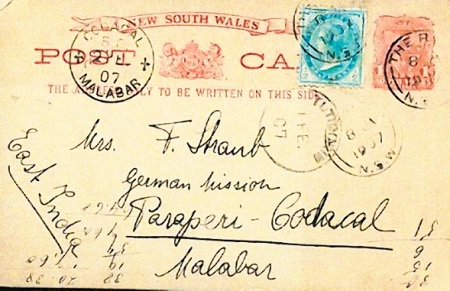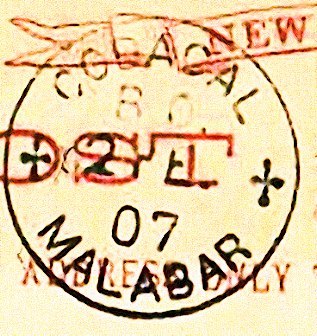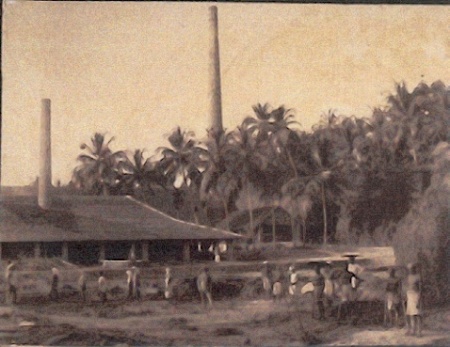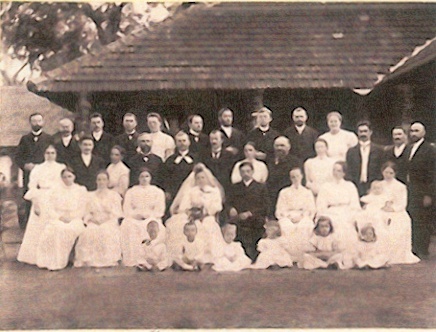This red 1d N.S.W. ‘Shield’ postcard has a green ½d stamp added, and both are postmarked ‘THE ROCK/ 8 JA/ 1907/ N.S.W’ [Type 1D (i), in use 1896-1914)]. It is addressed to Mrs.F. Straub, German Mission, Paraperi - Codacal, Malabar, and a vertically placed ‘East India’ has been added by the sender. There is a third example of ‘The Rock’ postmark as well as a transit mark of ‘TUTICORIN/ 1 FE./07' and an arrival postmark of ‘CODACAL/ B.O. (Branch Office)/ + 2 FE +/ O7/ MALABAR’ (Figures 1 & 2).
 |
 |
The small township of The Rock, 225 m above sea-level, is 497 km south-west of Sydney with the closest main town of Wagga Wagga, 31 km to the north-east. Situated in a wool and wheat area it was once occupied by the Wiradjuri Aborigines. The town is named after a local geological feature, a craggy outcrop which dominates the immediate landscape. Rising 364 m from the flat plains of the Riverina it can be seen from miles around. The current population is about 800. The postcard may have been sent overland or by train to either Sydney or Melbourne in order to make the sea journey to India, but there are no additions routings to confirm either.
At either Australian port, it would have been transferred to a ship and subsequently off-loaded at the port city of Tuticorin, in the south-east of India. Thoothukudi is also known as Tuticorin, and is a city in the State of Nadu, India (also known as “Pearl City”). It is a major seaport which serves the south east area of India, and it has a history dating back to the 6th Century B.C. The postcard could have been transported by land or rail to Codacal, and this journey only took one day. The total journey however took 30 days.
So far, this is fairly straightforward, whereas every thing that follows is conjecture, except for the identification of the Mission at Codacal. The name of Mrs. Straub suggests a Germanic origin, in keeping with the ‘German Mission’, and my guess would be that she was the wife of a Lutheran missionary. Paraperi may have been the name of a house or property at Codacal, but I have no evidence to support either of these statements. Malabar is considerably easier to validate, but then again no actual town named Malabar has been found on numerous maps consulted by me or by an expert at the map website at the University of Texas. Malabar may have been a district, but the term is best known as ‘The Malabar Coast’.
Malabar Coast is not very helpful for pinpointing Codacal as the former stretches for ca. 845 km (525 miles) along the south-west coast of India from Goa to the southern tip of the peninsula at Kanniyakumri (Cape Comorin), primarily in the Kerala State and the northern part of Karnataka State. Codacal is not listed in current gazetteers of India, including Columbia Gazetteer of the World, U.S. Board of Geographic Names, East India Gazetteer 1828, Geographical Dictionary of Ancient & Medieval India, Global Gazetteer (web), World Gazetteer (web), nor in the Imperial Gazetteer of India, 1885.
German interest in India began in strange circumstances, almost by default. The Danish East India Trading Company acquired coastal territory spread over 45 sq. km in Thanjavur district in the 17th century and the territory was later ceded to the Danish Crown. King Frederick IV (1699-1730) planned to send missionaries to spread the gospel, but no Danish national came forward to join the mission. Many people from Germany filled Frederick’s wish and a Lutheran pastor sent a band of young German theologians for training in Copenhagen prior to being sent to India, and the missionaries became keen to learn the Tamil language. They found that the European view of the native people that “Malabarians were barbarians” was not true, and they set about converting them to Christianity. A German scholar learnt the traditional medical practice of the Tamils and wrote a treatise, Malabar Medicus, and another compiled A Malabar and English Dictionary.
Daniel Mall was born in Sölligen, Germany in 1878 and at the age of 24 he received a divine call to dedicate his life to the Lord as a missionary. He offered his services to the Basel Mission in Switzerland and was accepted for training in 1902. However he was advised to enter their Technical instead of the Theological School to prepare himself for management of one of their seven tile factories in India.. In addition to his studies in tile and brick making, he attended the Bible instruction classes in the mission house as well as morning and evening prayer meetings. On November 28, 1905 Daniel Mall, in the presence of the mission congregation was released for his work in India.
I am making no claim that Mall had anything to do with the present postcard (other than timing, place of abode and working at a Mission), but in his biography we obtain our first indication of life in Codacal. The following passages from his biography are unrelated selections, in which Codacal, Mission and Malabar are mentioned:
On December 1, 1905 Mall left Basel, the following day he was in Trieste, he sailed for Port Said, thence reached Bombay on December 23, and boarded a railway car for Poona and thence to the railway station at Edacollam. He was greeted heartily by Mr. Friedrich. Boas, the manager of the tile factory in Codacal and he was taken by a flower bedecked 2-wheeled 2-bullock cart (Bandy) to his destination, the Basel Tile Works P.O. Codacal.
On December 1, 1905 Mall left Basel, the following day he was in Trieste, he sailed for Port Said, thence reached Bombay on December 23, and boarded a railway car for Poona and thence to the railway station at Edacollam. He was greeted heartily by Mr. Friedrich. Boas, the manager of the tile factory in Codacal and he was taken by a flower bedecked 2-wheeled 2-bullock cart (Bandy) to his destination, the Basel Tile Works P.O. Codacal.
As they drove along he was told of the country and customs, the large rice fields and numerous irrigation wells, the land having been acquired by the Basel Mission for the digging of the tile clay. Young boys stationed every 400 yards along the way raised arms and saluted the young “sahib”. The news had already reached the Mission Houseand on arrival he was welcomed by Rev. R. Bosshard.
On January 2, 1906 he accompanied Mr. Boas to Ponani, the nearest seaport whence the tiles were shipped to foreign ports. The Bharta River, which flowed past the MissionStation to the sea, was at low ebb during the dry season. Thus part of their journey was by bullock and part by pole-driven boat. As they neared Bonani, he saw women knee-deep in water collecting clams, as well as an alligator sunning himself.
They rested after dinner (the curried fish with seven spices was a little too hot for Mall, but he natives ate the curry even more spiced, as they thought that the spices controlled the intestinal worms), for this was the custom in the hot tropical climate, forCodacal is situated 11 degrees above the Equator.
Mall was told of the history of Basel Mission among the heathen people of India. TheMission in Malabar was founded in 1839; in 1843 a colony with rice fields was founded in Codacal and in 1862 became a Mission Station, with a church in 1869. In 1903 the congregation consisted of 263 members and 10 catchumens. The tile factory, a bungalow and garden followed. On January 8, 1906 Mall attended a great consecration festival of the newly built high school for boys in Calicut, the capital of Malibar, and he met the brothers and sisters of the Basel Mission, as well as Lydia Mueller, a nurse in the Mission Hospital, who later became his wife, when they married on 3 March 1908. He took over the management of the Codacal tile factory on 1 April, 1906, later becoming the permanent manager. In spite of his heavy duties he maintained a Sunday School, distributed Christian pamphlets to the Hindus, and attended the annual conferences of the missionaries. In 1914 Mall, his wife and 3 children returned to Germany.
Mall was told of the history of Basel Mission among the heathen people of India. TheMission in Malabar was founded in 1839; in 1843 a colony with rice fields was founded in Codacal and in 1862 became a Mission Station, with a church in 1869. In 1903 the congregation consisted of 263 members and 10 catchumens. The tile factory, a bungalow and garden followed. On January 8, 1906 Mall attended a great consecration festival of the newly built high school for boys in Calicut, the capital of Malibar, and he met the brothers and sisters of the Basel Mission, as well as Lydia Mueller, a nurse in the Mission Hospital, who later became his wife, when they married on 3 March 1908. He took over the management of the Codacal tile factory on 1 April, 1906, later becoming the permanent manager. In spite of his heavy duties he maintained a Sunday School, distributed Christian pamphlets to the Hindus, and attended the annual conferences of the missionaries. In 1914 Mall, his wife and 3 children returned to Germany.
To date (June 2006), this biography is the only worthwhile source of data concerning life in Codacal, and multiple searches with the assistance of other researchers has failed to find information that ties the postmark Codacal/Malabar to the German Mission. A recent clue was the finding of a present-day branch of the South Malabar Gramin Bank, located in the Malappuram district of Kerala which lists its post office as Codacal. The town of Malappuram in Malappuram District is located at co-ordinates 11 degrees 4 minutes North and 76 degrees, 4 minutes East. The 11 degrees North is consistent with the statement in the above biography that Codacal lies 11 degrees north of the equator. None of the India postmark websites give any information concerning Codacal (and most of their email addresses are not active ones), and the only India postmark enthusiast I could reach elsewhere admitted he knew nothing of the town or the specific postmark.
Up to now I have purposely presented the research in roughly date-acquired order, and persistence over the next month added credence to some of my previous assumptions. I repeatedly went back to a German Missions in India website, and linked into a whole series of photographs, many of which showed the Mission tile factory of Calicut (as it was known at the time of the postcard, a.k.a. Khozikode, Kozhikkot, Kolikod, and Kalikut) which lies at sea level, with co-ordinates of 11 degrees 15 minutes north and 75 degrees 46 minutes east. I made a further conjecture that the ‘old’ Codacal (of the early 1900's) was in the approximate area of Calicut, but somewhat inland. The Malabar Mission Tile Works is shown in Figure 3.
 |
One of these photographs links Daniel Mall, the early tile factory manager Mr. Friedrich Boas, and Daniel’s wife, Lydia Muller to this unfolding story, and adds credence to my speculations concerning the postcard’s addressee, Mrs F. Straub. The three first-named persons are in the Mall’s wedding photo, and another participant is named as Mr. Johann Friedrich Straub. Mrs Straub’s name is not shown in the listing, but could have been present amongst the women in the group photo. Only the bride and groom can be definitely identified (Figure 4).
 |
The most recent piece of information came from the project manager of the Malabar Mission Society, as follows: “Codacal P.O. is still a postal address. The full address now would be Codacal P.O., Malappuram District, Kerala State. The ancient term “Malabar”, from 1792-1956 was also the name of the district of the Madras Presidency at the date of your postcard, hence the address. East Indies was a common term for India at that time. Paraperi is a rural sub-section of Codacal. It was the site of a mission bungalow of the Basel German Evangelical Missionary Society. Mrs. Straub was probably a missionary there. The work of that society was turned over to the Church of South India which conducts a mission hospital at Codacal.”
All that remains in my personal quest of understanding the background of this interesting postcard sent from a small town in New South Wales, is to obtain additional information concerning use of the elusive Codacal/Malabar postmark. Well, not quite, for I have not been quite frank with you, for the postcard’s reverse had an extensive personal message written in German, which was very difficult to read, but was no more relevant than a description of a Christmas tree.
I wish to acknowledge the fine assistance of two people in regards to a search for Codacal in maps and gazetteers (James Wieferman, University of Texas and Gordon Beck, McMaster University, Hamilton Ontario), as well as Roland Miller of the Malabar Mission Society for information about the mission at Codacal.
Source-APH&SP department,Australia.

No comments:
Post a Comment